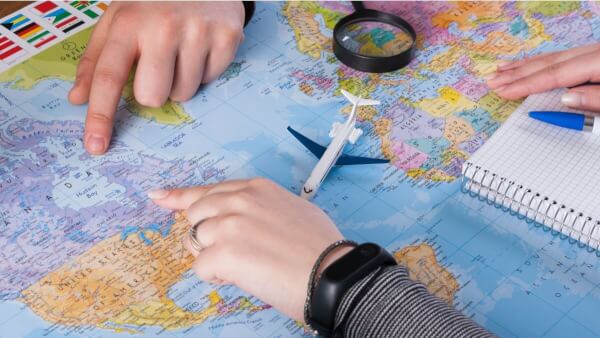Cash or card in Canada: Which is the best way to pay?
Should you pay with cash or card in Canada? A handy guide including cash etiquette, Canadian ATMs and using your UK card.

If you’re headed to Canada any time soon, you’re going to buy Canadian Dollars.
Luckily, despite its low population density, Canada has a large number of ATMs. With about 223 ATMs for every 100,000 adults, you’ll never have to wait too long to make a withdrawal.
Here’s how to find - and use - ATMs in Canada.
There are thousands of ATMs (also known as ABMs, or automatic banking machines) in Canada - over 65,000 to be exact. You’ll find them in bank lobbies and next to bank branches, but also in other places, including shopping malls, supermarkets, petrol stations, bars and restaurants.
The country’s five largest banks - Royal Bank of Canada, Toronto-Dominion Bank, Scotiabank, Bank of Montreal and Canadian Imperial Bank of Commerce - operate their own branded ATMs. They also form part of several interbank networks, including The Exchange.
You’ll also find various independently operated ATMs called white label ATMs, because they lack any bank branding.
You should check if your card will work in Canada by asking your bank ahead of time. You should also let them know when you’ll be away. Otherwise, your Canadian transactions may be considered suspicious and your card blocked for security reasons.
Canada has its own local card network, called Interac. However, most ATMs will also be compatible with Cirrus and Maestro, Plus or both. Look out for your card network’s logo on an ATM before you try using it. You can also find the nearest compatible ATM through Visa’s online locator (for Plus cards) and MasterCard’s ATM locator (for Cirrus and Maestro cards)
You don’t need a chip-and-pin card to use a Canadian ATM. Cards with just a magnetic stripe on the back work too. Most ATMs accept four-digit numeric PINs. Some ATMs (primarily those operated by Royal Bank of Canada and Toronto Dominion Bank) also accept six-digit PINs.
Free ATMs are rare in Canada. Most charge between CAD$2 and CAD$5 in withdrawal fees. Independently operated ATMs often have higher fees than ATMs operated by banks.
Your bank back home may also charge fees. Usually, you’ll be charged an ATM access fee and a foreign exchange fee. These fees are in addition to those charged by the Canadian ATM.
Remember to always perform ATM transactions in the local currency, i.e. Canadian Dollars. That way, you’ll get the mid-market rate, which is the fairest CAD exchange rate possible. If you choose to be charged in your home currency, the ATM will make up an exchange rate, which often means more for the bank and less for you.
Here’s how you can avoid (or at least reduce) your exposure to ATM fees.
Some ATM networks in Canada offer free withdrawals to customers of participating banks:
Scotiabank, one of Canada’s largest banks, is part of the Global ATM Alliance. If you bank with an Alliance member, you can use Scotiabank’s ATMs without paying an ATM fee.
Allpoint, which has 55,000 ATMs in Canada, the US, UK, Australia and Mexico, also offers fee-free withdrawals. You can check if your card works with Allpoint ATMs by using this online card checker.
HSBC offers Advance and Premier customers fee-free withdrawals from its worldwide network of ATMs. It has its own network in Canada and also participates in The Exchange.
The Accel network is a US network of ATMs that’s partnered with fee-free Canadian ATM network, The Exchange. If you hold an Accel card, you can use The Exchange ATMs without paying an ATM access fee.
Even if your bank doesn’t participate in one of these networks, you may still be able to use specific ATMs without paying a withdrawal fee. You can find out by asking your home bank whether it has a correspondent banking relationship with a Canadian bank.
Whenever possible, you should make ATM withdrawals using a debit card. Credit cards often have higher fees. They also treat withdrawals as loans, which means the amount will attract interest.
You should also check your card’s terms and conditions. Some cards do not attract foreign transaction fees, which makes them cheaper to use abroad.
Canadian ATMs charge a flat fee per transaction. You can often keep costs down by making one large withdrawal instead of several smaller ones. Ask your home bank what your daily withdrawal limit is and use it to your advantage. If you think it’s too low, ask your bank if it can raise it before your trip.
If you have a Canadian bank account, or know someone who does, use Wise to make the transfer ahead of time and save even more. Not only does Wise use the real mid-market exchange rates to convert your money (which almost always beats the banks), but since your currency is received and sent via local banking systems in both your home country and in Canada, all those nasty international fees magically disappear. Give it a try.
*Please see terms of use and product availability for your region or visit Wise fees and pricing for the most up to date pricing and fee information.
This publication is provided for general information purposes and does not constitute legal, tax or other professional advice from Wise Payments Limited or its subsidiaries and its affiliates, and it is not intended as a substitute for obtaining advice from a financial advisor or any other professional.
We make no representations, warranties or guarantees, whether expressed or implied, that the content in the publication is accurate, complete or up to date.

Should you pay with cash or card in Canada? A handy guide including cash etiquette, Canadian ATMs and using your UK card.

Check out our in-depth guide on everything you need to know about buying a prepaid Canada SIM card, including different providers, pricing, and features.

Travelling to Canada? Read our roundup of the best UK credit cards to use in Canada, comparing interest rates, fees and more.

Read our guide on the best travel card for Canada, including card comparisons and travel tips.

Can I use Revolut in Canada? A handy guide covering using your Revolut card in Canada, spending in CAD and much more.

Whether you call it the Great White North or just Canada, the reality is still that there are restrictions on how much cash you can take in or out. If you...